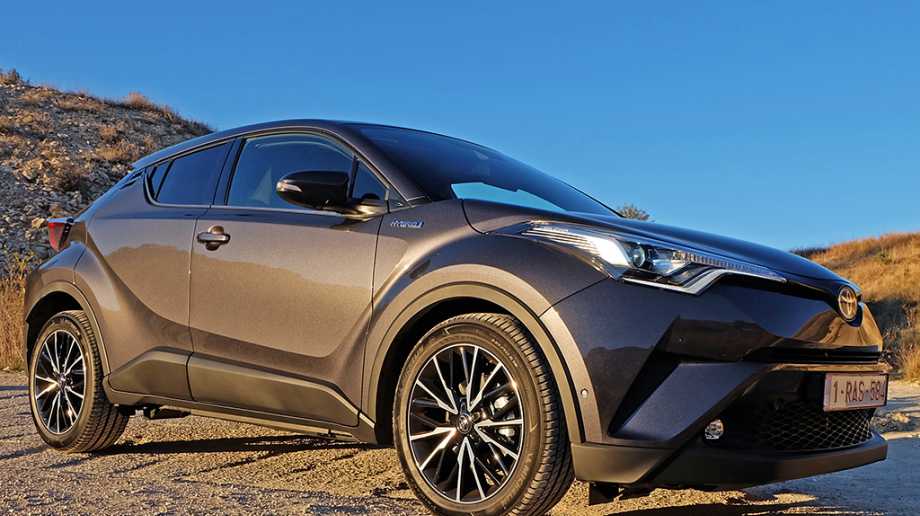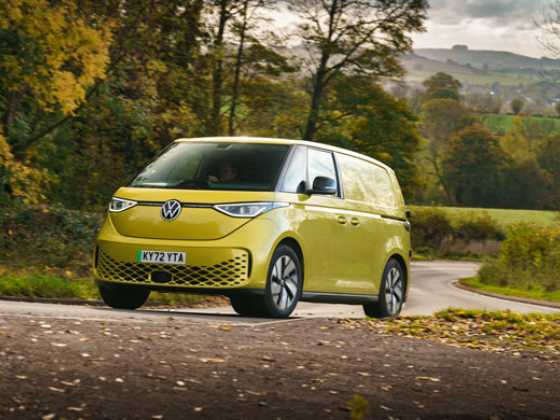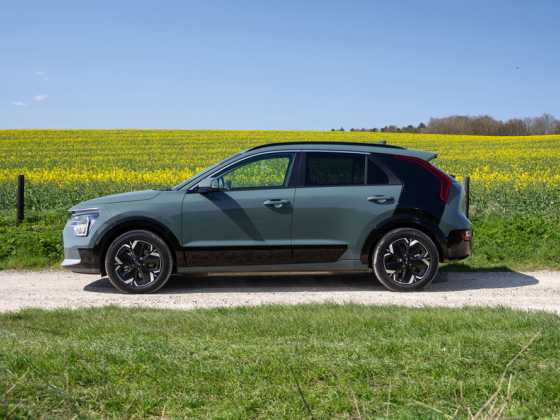First Drive: Toyota C-HR Hybrid

The Toyota C-HR is the latest entry into the busy mid-size crossover market. Richard Gooding gets under its distinctive skin and finds a hybrid powertrain, low emissions, and Lexus-like luxury.
What is it?
With sales worth over 115,000 units per year, the ‘C-segment’ crossover market is a growing one. Recent entries including the SEAT Ateca and Volkswagen Tiguan have joined the ranks of more established rivals such as the Renault Kadjar and Nissan’s all-conquering Qashqai.
Toyota has been missing from this segment until now – welcome the C-HR, which stands for 'Coupé High Rider’ and gives a clue to the main difference its latest model has over the competition.
With a distinctive sloping roofline, the C-HR attempts to bring coupé looks to a segment which typically sees more staid ‘box-like’ styling. And it certainly appears to stand-out among other potential rivals such the Hyundai Tucson and Kia Sportage, its refreshingly and multifaceted looks designed to appeal to younger drivers.
First shown at the Paris motor show as a concept in 2014, the C-HR has made it into production almost unchanged. Therefore, it’s the most daringly-styled car in Toyota’s current line-up.
As the Japanese manufacturer states, it’s no “me-too” product: exclusively designed for European markets, the C-HR features the latest Toyota New Global Architecture (TNGA) platform just like the latest Prius (GreenFleet issue 93), and is the first TNGA chassis to be developed in Europe. It has one other distinct advantage none of its rivals can boast: an economical hybrid powertrain, which should appeal to fleet managers and drivers alike.
How does it drive?
The wild ‘look-at-me’ styling plays tricks on perceptions, as the C-HR looks as small as a Nissan Juke, but is actually as large as that car’s larger Sunderland-built sister. And while that tapering roofline takes the edge off practicality, there should be room for most. Visibility is hindered by the small back windows, though, the rising door line and black headlined-cabin making the rear seats feel quite claustrophobic.
The reason? The external hidden rear door handle, which is essential for the C-HRs coupé-like and three-door-aping appearance. Luggage space of 377 litres is around 60 litres less than the competition, but a well-shaped loading area makes up for this a little.
Like the exterior, the interior of the C-HR has been transferred from concept to production car with minimal changes. In a similar vein to the outside, the cabin is bold, with the central touchscreen for the infotainment system angled towards the driver.
Vivid colour strips dissect the dashboard depending on trim, and overall, the C-HR seems to borrow high-quality fittings from its Lexus cousins. It’s a comfortable and cosseting place in which to sit, the leather trim and gloss plastic on our launch models creating an impression of luxury.
A pair of petrol engines are available for the C-HR. A 1.2-litre turbocharged unit develops 114bhp with torque of 136lb ft, and is mated to a new six-speed manual gearbox, with the option of a CVT automatic. The newly-developed Intelligent Manual Transmission (IMT) is a Toyota first, and matches the engine revs to the gearbox ratio selected for a smoother drive.
We were unable to test the 1.2T car, but with emissions starting at 134g/km and claimed combined economy of 47.9mpg, GreenFleet readers may be more interested in the hybrid version which is forecasted to take 75 per cent of C-HR sales in the UK.
All hybrid C-HRs are front-wheel drive only: only selected 1.2-litre turbocharged cars can be specified with all-wheel drive. Sharing the fourth-generation Prius’ 1.8-litre, 97bhp petrol engine and 53kW/71bhp electric motor, the hybrid powertrain C-HR promises emissions as low as 86g/km with potential economy of 74.3mpg.
For efficiency reasons, the hybrid C-HR is only available with a CVT automatic gearbox (which differs from the version fitted to the 1.2T), and while it may promise high fuel returns and low emissions, the auto feels strained and is quite vocal at higher revs. Much better suited to lower speeds around town, urban areas are environments in which the C-HR hybrid feels more at home.
That’s not to say it feels out of its depth on the open road. Far from it in fact. The C-HR has the lowest centre of gravity in its class and it shows. European roads provided an extensive part of the C-HR development programme and the car was benchmarked against more traditional C-segment hatchbacks as opposed to its mainstream crossover competition. Chief engineer Hiroyuki Koba wanted a more dynamic drive, and the C-HR largely delivers just that.
The new Toyota crossover has little body roll, and corners flatly and precisely for an SUV. It can be placed on the road accurately, and nicely-weighted steering and an inherent nimbleness make the C-HR fun to drive. The suspension features ball-joint connections for the lower arms rather than the rubber bushes used by the Prius, and improved responses are just one of the key benefits.
Nicely-damped, our high-specification test car rode well on its 18-inch wheels, with very few bumps from the launch venue’s Spanish roads transferred into the cabin. When the CVT gearbox isn’t revved hard, the C-HR hybrid is nicely refined, too, although wind noise is more noticeable than perhaps it should be.
Unlike its larger RAV4 brother, the C-HR runs on electricity much more readily and for longer durations, the car shuffling the power sources to give what it thinks will be the best economy.
How economical is it?
Toyota claims combined cycle economy figures of 74.3mpg on C-HR Hybrid models with 17-inch wheels, and 72.4 on cars with 18-inch rims. Over our 250-mile real-world test route around Madrid, our 18-inch-wheeled car returned an average economy of 53.2mpg.
While that’s some way short of its official figure, it is more than acceptable given the C-HR’s size, if not quite so parsimonious as diesel-engined rivals, which of course can cost more to tax.
Unique in the C-segment SUV/crossover market due to its petrol-hybrid powertrain, there are no plans for a diesel C-HR. Only the new Renault Scenic offers a ‘hybrid-assist’ option: its 10kW electric motor aiding its diesel engine under acceleration to improve fuel economy.
What does it cost?
Toyota has made the C-HR model line-up simple, with three trims that echo other vehicles in its range. The entry-level Icon Hybrid starts at £23,595 and includes kit such as automatic headlights and wipers, a dual 4.2-inch TFT multi-information display, dual-zone automatic air conditioning, eight-inch Toyota Touch 2 infotainment system with six speakers and DAB/Bluetooth/AUX-IN/USB connectivity, keyless entry and push-button start, LED daytime running lights, rear-view camera, and 17-inch alloy wheels.
Excel grade C-HR Hybrids cost from £26,495 and add an eight-inch Toyota Touch 2 with Go infotainment system with DAB/advanced Bluetooth/AUX-IN/USB connectivity as well as access to connected services, front and rear parking sensors, heated front seats (with power lumbar support on the driver’s chair), part leather upholstery, rear-view camera, and 18-inch wheels. Blind spot monitoring and rear cross traffic alert safety systems are also standard.
Additional benefits of Dynamic trim (£27,995 upwards) include ‘Dynamic’ purple cloth upholstery, LED headlamps/rear lights/fog lights, standard metallic or pearlescent paint, and a bi-tone paint finish with a contrasting black roof. Both Dynamic and Excel-trim cars also have the option of a 10-speaker JBL sound system, which has been specially developed for the C-HR by the audio specialist.
All models come with the latest version of the Toyota Safety Sense collection of systems (pre-collision, pedestrian detection, adaptive cruise control, lane departure alert, automatic high beam, road sign assist) and nine airbags as standard. A range of option packs is also available to enhance the already comprehensive specification.
How much does it cost to tax?
The Toyota C-HR Hybrid has CO2 emissions of 86g/km and 87g/km when fitted with 17 or 18-inch wheels respectively. Therefore, all versions regardless of trim are exempt from road tax as they slot into VED Band A. Benefit in Kind is among the lowest in its class at 15 per cent, with most of its heavy-hitting rivals rated at 19 to 21 per cent.
Why does my fleet need one?
In Toyota’s eyes, the C-HR is an additional core model and very definitely not a niche product: 100,000 annual sales are forecast – 16,000 of those in the UK – with the new car aimed at taking 15 per cent of the Japanese carmaker’s total sales in 2017. Although primary a retail proposition, 44 per cent of C-HR sales will be to the fleet market, and Toyota forecasts the new car to take 11 per cent of the C-segment crossover market as a whole.
One big selling point of the C-HR is its forecasted low running costs. The Japanese manufacturer is citing longer component durability on hybrid parts such as brake discs and pads, as well as tyres. All C-HRs also have Toyota’s standard 5-year/100,000-mile warranty as party of the package, too, while hybrid models also receive an annual hybrid 'health check’.
A genuinely interesting entry into the growing C-segment crossover market, the Toyota C-HR mixes daring and distinctive styling, a luxurious interior and a segment-unique powertrain to offer a vehicle which is truly different. Low emissions and a decent drive should help Toyota attain the market penetration it desires, as the capable C-HR fires a much-needed creative riposte to the established competition.









